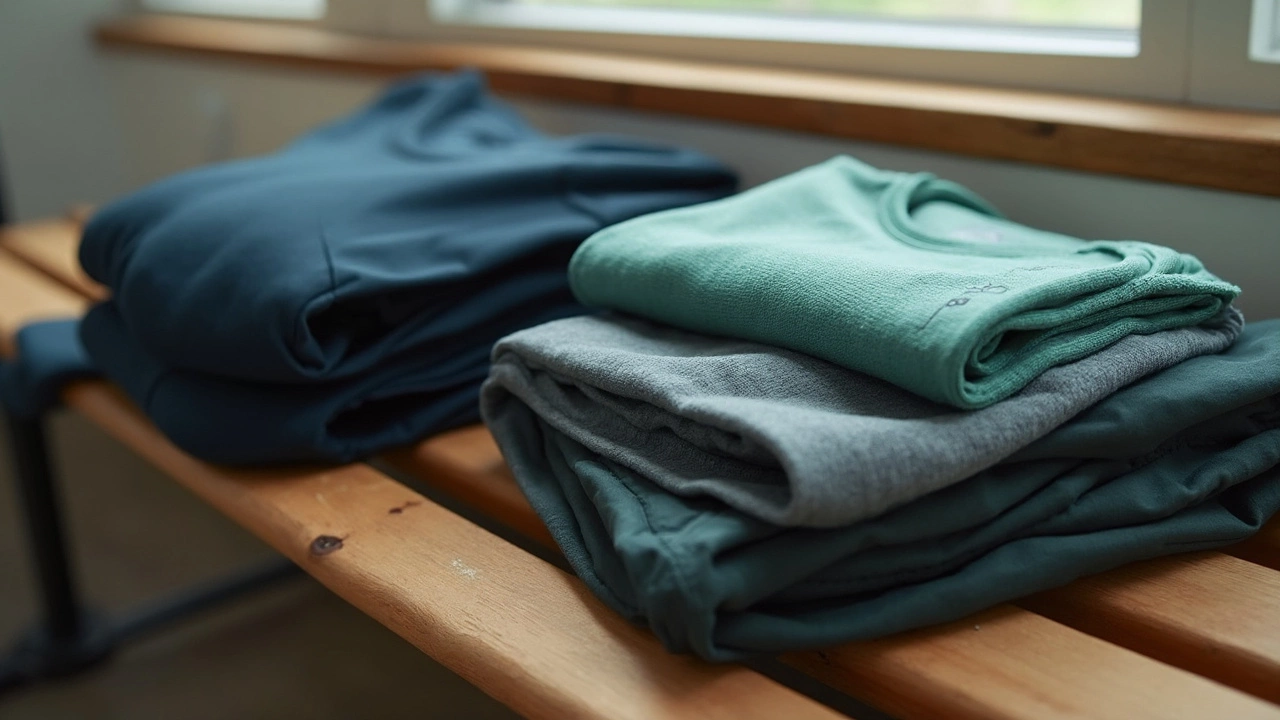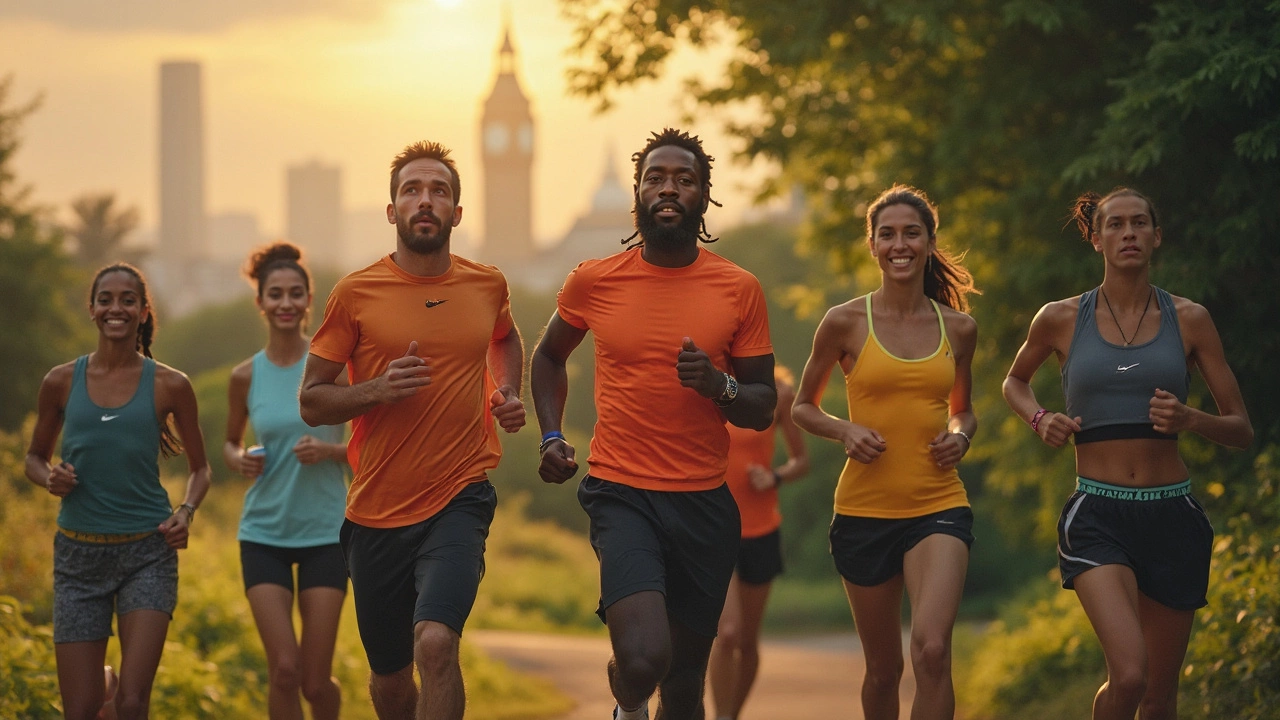Start pulling clothes from your closet, and suddenly it hits you—what even counts as sportswear? It’s not just any comfy T-shirt or a pair of stretchy pants. Real sportswear is built for movement, sweat, and staying put no matter what workout you’re doing.
Ever notice how your favorite gym shirt dries super fast and seems to never get heavy? There’s a reason. Modern sportswear is packed with clever materials—like moisture-wicking polyester blends—that help you stay cool and avoid that sticky feeling. Good sportswear also tends to stretch the right way, bouncing back even after a rough session, so you never have to deal with saggy knees or baggy elbows.
- What Really Defines Sportswear?
- Materials and Tech Features
- Fit and Functionality
- Versatility Beyond the Gym
- Choosing the Right Sportswear
What Really Defines Sportswear?
When you look at sportswear, it’s built for a reason: function, not just fashion. It’s not about flashy logos or trendy colors—it’s about the nitty gritty of what makes clothes work for exercise, training, and movement.
At the core, athletic clothing is designed to keep up with your body. It supports muscles, flexes when you stretch, and handles sweat in a way regular clothes just don’t. That’s why those everyday cotton shirts soak up sweat and cling, while true workout gear stays light and comfortable.
Some concrete things that set sportswear apart:
- Performance fabrics: Think polyester, nylon, spandex—these wick away sweat, dry quickly, and often resist odor.
- Construction and seams: Flatlock seams help stop chafing and feel smoother against the skin.
- Ergonomic fit: Sportswear is intentionally cut and stitched so that it moves well with your body, not against it.
- Built-in features: Lots of gear now has pockets for phones, mesh panels for ventilation, or reflective strips for safety.
There’s even a standard in the industry called “athleisure,” which blurs the line a bit. But if it’s truly activewear, it should do the heavy lifting on comfort, performance, and durability. No one wants leggings that become see-through after one squat or a shirt that smells awful after a single workout.
Here’s a quick snapshot of the difference between sportswear and regular clothes:
| Sportswear | Everyday Clothing | |
|---|---|---|
| Moisture Control | High (wicks sweat) | Low |
| Stretch/Flexibility | Engineered for movement | Minimal |
| Durability | Handles frequent washing | May lose shape quickly |
| Comfort Under Stress | Built for activity | Built for casual |
When you pick something labeled as sportswear, check the tag and how it feels when you move around. A pair of joggers may look cool, but if it holds onto sweat or restricts your movement, it’s just fashion, not performance. True sportswear is that gear you reach for again and again—because it simply works.
Materials and Tech Features
If you’re shopping for real sportswear, check the label before anything else. The secret is in the fabrics and tech woven into your gear. Basic cotton shirts soak up sweat like a sponge and leave you feeling soggy—no thanks. Modern athletic clothing usually uses polyester, nylon, elastane, or blends. These materials dry quickly and pull moisture off your skin, which is the whole idea behind moisture-wicking gear.
Let’s talk high-tech features too. Some workout gear uses mesh panels for extra airflow—like underarms or back zones that get really sweaty. Others add anti-odor treatments powered by silver ions. You’ll also spot gear labeled as "UV-protective" (UPF-rated), which is awesome for running or playing sports outside.
Fabric stretch is a big deal. Elastane (also called spandex or Lycra) is what lets your leggings snap right back into shape after yoga or squats. Compression clothing ups the game by adding extra support and blood flow, which can help muscles recover faster.
Brands love to tout "seamless" or "flatlock seam" designs that stop chafing. Trust me, after a long run, you’ll want those smooth seams. Also, don’t skip those tiny reflective stripes—anyone running or biking after sunset will thank themselves for picking visible activewear.
| Material | Main Benefit | Common Use |
|---|---|---|
| Polyester | Wicks sweat, dries quick | Shirts, shorts, base layers |
| Nylon | Soft, durable | Leggings, jackets |
| Elastane (Spandex) | Super stretchy | Tights, compression |
| Cotton Blends | Softer feel, but less sweat-wicking | Light workouts, loungewear |
Some sportswear is even made partly from recycled plastic bottles—Adidas and Nike have both sold millions of these pieces over the past five years. That’s an easy win if you care about the planet. Bottom line: pay attention to what your workout gear is made of, and don’t settle for basics if you want to feel good and perform better.

Fit and Functionality
The fit of your sportswear isn’t just about looking good at the gym—it directly affects your comfort, range of motion, and even your performance. Baggy shirts might get in your way, while tight clothing can restrict your movement and make you feel uncomfortable.
Brands have done plenty of research to figure out what works best. For most activities, you’ll see fitted tops and bottoms that hug your shape but leave room to breathe. Compression wear takes this a step further—studies show that compression leggings can help reduce muscle fatigue during runs or heavy lifting, and help you recover faster afterward.
When it comes to workout gear, small features make a big impact. Ever notice flat seams on your favorite leggings or shirts? Those reduce chafing, which matters a lot when you’re sweating. Thumb holes in sleeves keep them from riding up during stretches. Some shorts have built-in liners for more coverage, and many pants feature handy side pockets or hidden zippers so you can stash your keys or cards.
Here’s the lowdown on key fit and functionality features worth checking for:
- Stretch fabrics like spandex or elastane boost mobility for yoga, weightlifting, and sprints.
- Moisture-wicking material stops sweat from pooling or leaving marks, keeping you dry longer.
- Adjustable waistbands ensure nothing pinches or slides while you move.
- Gussets (diamond-shaped pieces of fabric at seams) in shorts or leggings relieve pressure and improve flexibility.
Some shoppers wonder if pricier activewear is worth it. A 2023 market survey found that people who wore well-designed, form-fitting activewear reported fewer distractions and more comfort during exercise compared to those in regular basics. When you’re comfortable and not fussing with your clothes, it’s just easier to focus on your moves.
Versatility Beyond the Gym
One of the coolest things about sportswear right now is that you don’t have to save it just for your next run or yoga class. These days, you’ll spot people wearing track pants, leggings, or athletic tees everywhere—coffee shops, the grocery store, and even at casual work spots. It’s not just a trend; brands are designing athletic clothing to look stylish and feel comfortable no matter where you are.
Let’s talk about why this works. Modern activewear mixes practical sports features—like stretch and breathability—with everyday style. That means you can go straight from spin class to meeting your friends for brunch and never feel out of place. In fact, a 2023 survey by the NPD Group found that nearly 40% of adults in the U.S. bought athletic apparel for non-sport use. People love being able to make a quick outfit switch simply by tossing a jacket or scarf over their gym top.
- Performance fabric tech keeps you dry and odor-free, so it’s totally fine if your day involves errands after a workout.
- Features like zip pockets and hidden pouches make it easier to keep your stuff close when you don’t want to carry a bag.
- Clever details—think thumbholes, reflective stripes, or vented panels—are designed to help in training but look pretty cool in everyday life too.
Some brands now even label certain gear as “athleisure,” so you know it’s made for more than just sweating. If you want clothes that fit every part of your day, keep an eye out for workout gear that doubles as casual wear. The key is to choose pieces that match your style—you won’t regret having clothes that work hard for you both inside and outside the gym.

Choosing the Right Sportswear
Picking out the right sportswear can make or break your workout. You want clothes that feel good, handle sweat, and don’t get in your way. Forget old cotton shirts—they soak up sweat and cling to you like glue. Instead, look for performance fabric labels like "moisture-wicking," "quick-dry," or "breathable mesh." These are made to pull sweat away from your skin and help you stay cool.
Fit is just as important. You don’t want baggy shorts that ride up or leggings so tight they cut off your circulation. Try moving around in the stuff you try on. Do some squats or reach up high. If anything slips or pinches, it’s not going to work for real exercise.
Think about the type of activity you do most. Runners usually go for lightweight gear with reflective strips for safety. If weightlifting is your thing, skip loose tops that bunch up when you’re on the bench. For yoga, soft, flexible fabrics and high-waist leggings are big winners.
- Check seams—they should be flat so they don't rub or cause chafing.
- Look for pockets if you run with keys or a phone.
- High-stretch fabrics with spandex or elastane give freedom to move in any direction.
- Stick with tried and true brands for quality—many do actually last longer and feel better over time.
Here’s a quick comparison of popular activewear fabrics and what they’re good for:
| Fabric | Best For | Watch Out For |
|---|---|---|
| Polyester | Running, HIIT, gym | Can hold onto odor |
| Nylon | Yoga, cycling | May snag easier |
| Cotton Blends | Casual use | Too much cotton = absorbs sweat |
| Merino Wool | Hiking, cold weather | Usually pricier |
If you’re shopping online, check the return policy. It’s hard to know how something feels just by looking. And don’t get fooled by loud colors and crazy prints—they won’t make up for bad fit or cheap fabric. Focus first on comfort, support, and the right features for your routine. That’ll always beat flashy labels or influencer hype.

